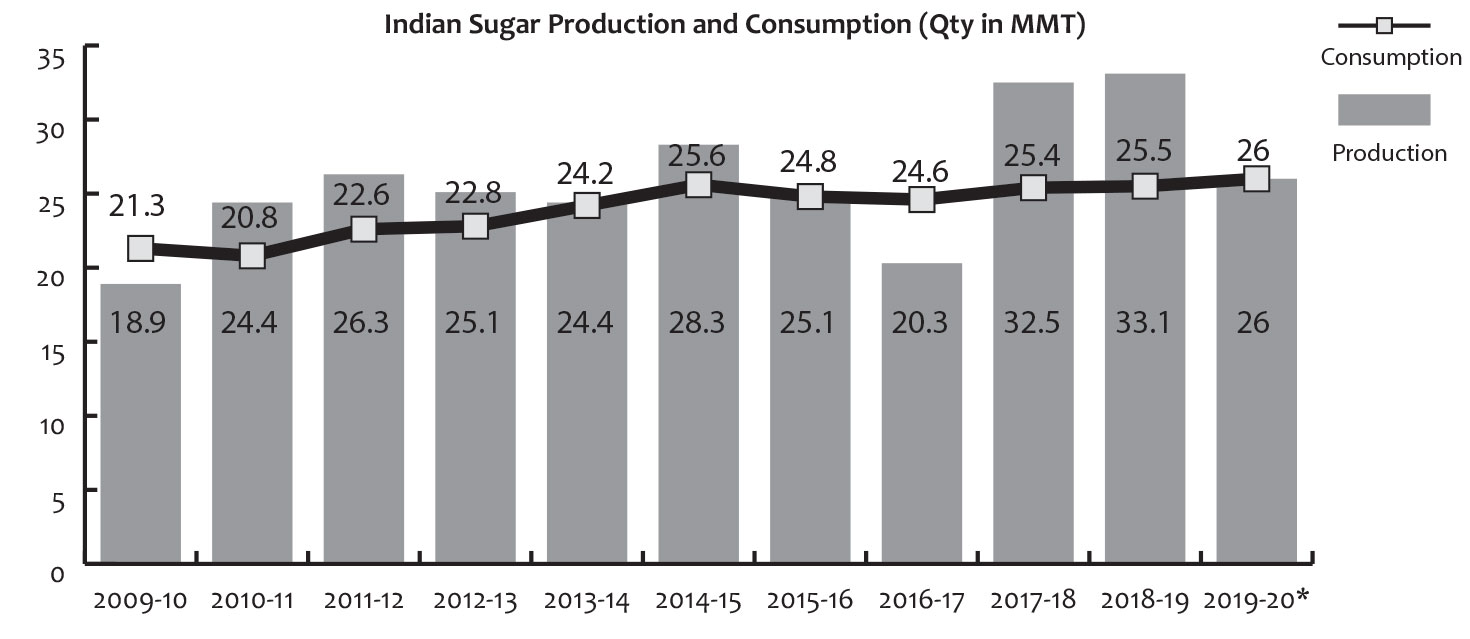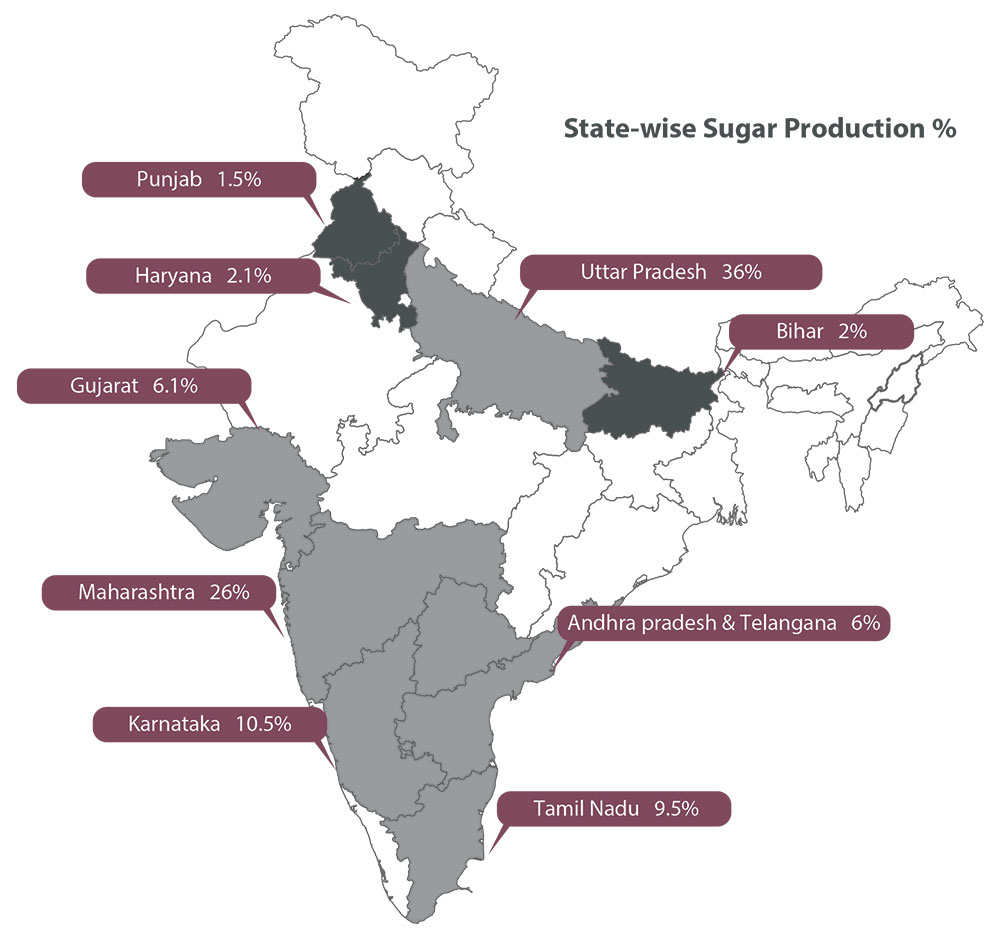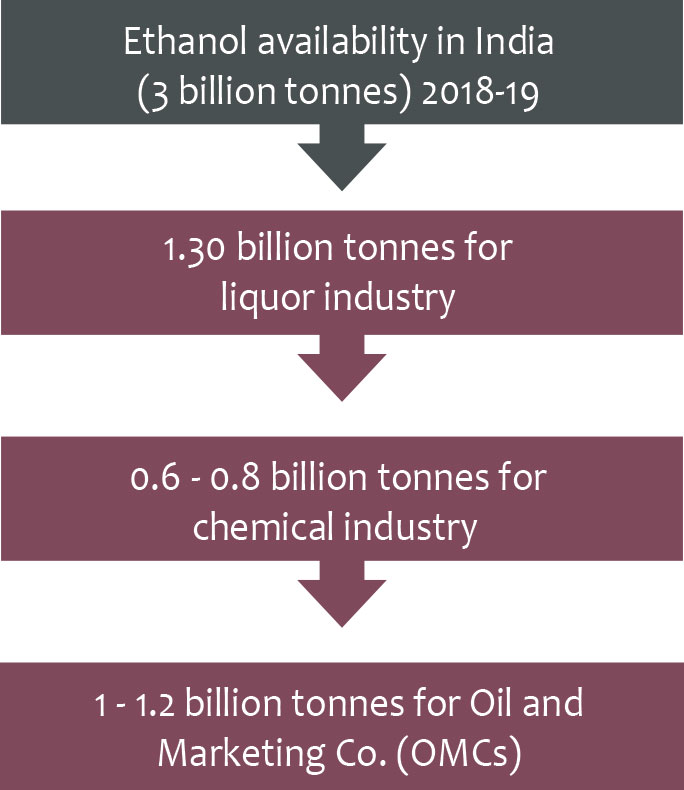The Sugar industry is one of the most important agrobased industries in India and is responsible for creating significant impact on rural economy and country’s economy. India became the world’s largest sugar producer in 2018/2019, beating Brazil for the first time in 16 years. India produced 33 million metric tonnes of sugar. That is 19% of the world’s total sugar production of 179 million metric tonnes. The nation is seeing record levels of sugar production due to increased sugar farmland and improved yields.
According to industry body Indian Sugar Mills Association (ISMA) Indian exports may cross 5 million tonnes in the ongoing marketing year ending September. Government has allowed export of 6 million tonnes of sugar under Maximum Admissible Export Quota (MAEQ) to help deal with the surplus sugar. And for the marketing year 2019-20 sugar production has touched 19.5 till end of February 2020, and it is expected to reach 26 metric tonnes by September 2020.

- Sugar-producing states
Sugar is produced in India primarily in nine major states. This industry caters to an estimated 12% of the rural population in these nine states through direct and indirect employment. In 2018–19, the six states of Andhra Pradesh, Gujarat, Karnataka, Maharashtra, Uttar Pradesh and Tamil Nadu each produced more than 1 million metric tonnes of sugar per annum, with the three states of Bihar, Punjab and Haryana producing less than 1 million metric tonnes of sugar. India’s 2018–19 sugar production was 33.0 million tonnes. Output in Uttar Pradesh, Maharashtra and Karnataka accounted for an 80% share of the country’s production. Uttar Pradesh tops the list in sugar-producing states with 11.8 million metric tonnes followed by Maharashtra with 10.72 million metric tonnes and Karnataka with 4.4 million metric tonnes in third position. Other states like Tamil Nadu, Gujarat, Andhra Pradesh, Telangana, Bihar, Punjab, Haryana, Madhya Pradesh, Chhattisgarh, Odisha, Uttarakhand accounted for a total of 6 million metric tonnes of sugar production.

- Top sugar-producing states outlook
Uttar Pradesh is the largest sugarproducing state in India with 119 operational sugar mills, of which 92 units belong to the private sector, followed by 24 and 3 factories operating in the cooperative and government sector respectively. States accounts for nearly 36% of total production. Maharashtra is the second largest producer of sugar in India, with 195 mills accounting for 26% of total production. Karnataka is the third largest sugarcaneproducing state of India with more than 10.5% share of production.
- Freight benefits for sugar industry
The government in August 2019 approved an export subsidy of Rs. 10,448 per tonne of sugar up to a maximum of 6 million tonnes, at an estimated cost of Rs. 6,268 crores. This lump sum subsidy to sugar mills covers the expenses on marketing, handling, processing and transport charges.
Further, in order to meet the export deadline, the Department of Food and Public Distribution has reallocated about 6 lakh tonnes of MAEQ from the sugar mills that up to 31st January 2019 had not made any efforts towards exports, to the mills who are willing to export more sugar.
| Sugar handling in India (2018–19) | |
| Type | (qty in MMT) |
|---|---|
| Containers | 2.2 |
| Bags | 1.5 |
| Bulk | 1.4 |
A commodity like sugar needs special handling. For logistics, certain norms and standards are followed to enable to move the cargo efficiently through road and sea without losses and maintaining high levels of hygiene. For the efficient movement of sugar from factories to the gateway port, cargos are routed through inland container depots (ICD). In 2018–19 India has moved nearly 2.2 million tonnes of sugar through containers, of which the major chunk is handled at gateway ports like JNPT (1.4) and Mundra (0.6). Kandla handles the highest volume of 1.5 million tonnes of sugar in bulk and bag sugar.
| J M BAXI GROUP’s sugar-handling infrastructure at Indian ports | ||
| Port | Cargo | Infrastructure |
|---|---|---|
| Kandla | Bulk/bags | • Private warehouses • Payloaders for cargo heaping/pushing at warehouse and wharf • Dumpers for cargo carting • Private grabs • Gear supply • Steel mesh on vessel holds with fishing nets • Labour for operations at warehouse, wharf and rake handling |
| Mangalore | Bulk | • Private/port warehouses • Payloaders for cargo heaping/pushing at warehouse and wharf • Dumpers for cargo carting • Mobile harbour crane with grabs • Labour for operations at warehouse, wharf and rake handling |
| Mumbai | Bags | • Port warehouses • Trucks for cargo intercarting • Gear supply • Labour for operations at warehouse, wharf and rake unloading |

- By product market –ethanol
India, which is over 80% dependent on imports to meet its oil needs, has mandated blending of up to 10% ethanol in petrol but inadequate availability has restricted this to under 4%. To improve this situation, ISMA has estimated 8lk tonnes of sugar cane production diverted to ethanol production in the 2019–20 season. India’s annual requirement of ethanol is 5.11 billion litres as against current capacities of 3.5 billion litres. With the increased supply of sugarcane, ethanol production is now estimated to increase for 2019–20 season.

(to be continued in issue XXX)